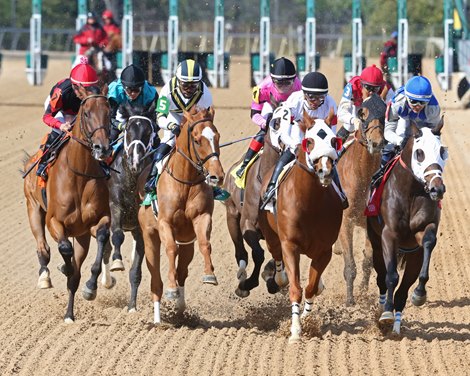This winter, the Horseracing Integrity and Safety Authority and Oaklawn Park launched a pilot program under which a designated barn would be used for veterinarians to administer any intra-articular corticosteroid injections in the presence of Oaklawn’s integrity department.
Now, the track has announced that beginning Jan. 25, it has enhanced its house rule to include that any repeated intra-articular corticosteroid injection to the fetlock joint requires the attending veterinarian to perform a radiograph (also known as an x-ray) of that fetlock joint. The move was made in partnership with the Arkansas Horsemen’s Benevolent and Protective Association and in consultation with the Grayson Jockey Club veterinarian staff, an Oaklawn release stated.
To assist in the costs of the required digital imaging, the Arkansas HBPA and Oaklawn will pay up to $250 for each required set of radiographs.
“The attending veterinarian will then assess the fetlock joint radiograph for potentially dangerous findings before the repeated injection is administered,” an Oaklawn release stated.
Arkansas HBPA president Bill Walmsley said the rule came about after conversations between Oaklawn officials, including feedback from track president Louis Cella, and the Arkansas HBPA.
Sign up for BloodHorse Daily
“We thought we might actually accomplish some good of keeping a horse off the track that might otherwise have sustained a catastrophic injury,” Walmsley said.
Walmsley, who also owns horses, said his trainer informed him that a radiograph would be performed as a standard practice for a horse needing a second fetlock injection in 60 days. Walmsley suggested the radiograph mandate would apply to only a small percentage of horses.
“So far in the meet, there’s only been two instances of a horse receiving a fetlock injection twice within 60 days,” Walmsley said. “So I’m thinking through the race meet (from Dec. 8-May 4), if it happens 10-20 times, that’ll be probably the max that it’ll happen.”
Studies have shown the fetlock joint contributes to a sizable portion of equine injuries, leading to increased regulation by authorities related to that joint. This past fall, HISA requested a revised rule that, pending approval from the Federal Trade Commission, would extend the stand-down period for fetlock injections from 14 to 30 days before a horse can race.
This had been the regulation in California before HISA rules under the 14-day stand-down period took over. Officials for the CHRB credit their rule for reducing breakdowns after its implementation.
The CHRB later passed regulations in which a horse that receives more than two injections into the same joint within 60 days must be placed on the veterinarian’s list and be unable to race for 30 days, regardless of the substance administered. Then Sept. 21, a California regulation was passed stipulating that a horse cannot receive an intra-articular corticosteroid injection without diagnostic imaging showing a need for it. That pending measure is likely to go into effect next spring and, like restrictions on injections into the same joint, can be applied since there is no conflicting HISA regulation.
According to Oaklawn, the terms and requirements of the injection program apply for the balance of the current Oaklawn racing season. The procedures are in addition to any applicable HISA rules and rules of the Arkansas Racing Commission.
Jason Milligan, Oaklawn Park’s vice president of racing, did not immediately return a message seeking comment about the new program at Oaklawn.
Asked about the reaction from his membership about the new program, Walmsley said: “There’s always disagreement when you’re talking about horses and treatment of horses. But no, I think the vast majority of the my members that I’ve talked to feel like it’s a good, proper practice to follow.”








Leave feedback about this